2007 CHEVROLET AVEO light
[x] Cancel search: lightPage 142 of 436
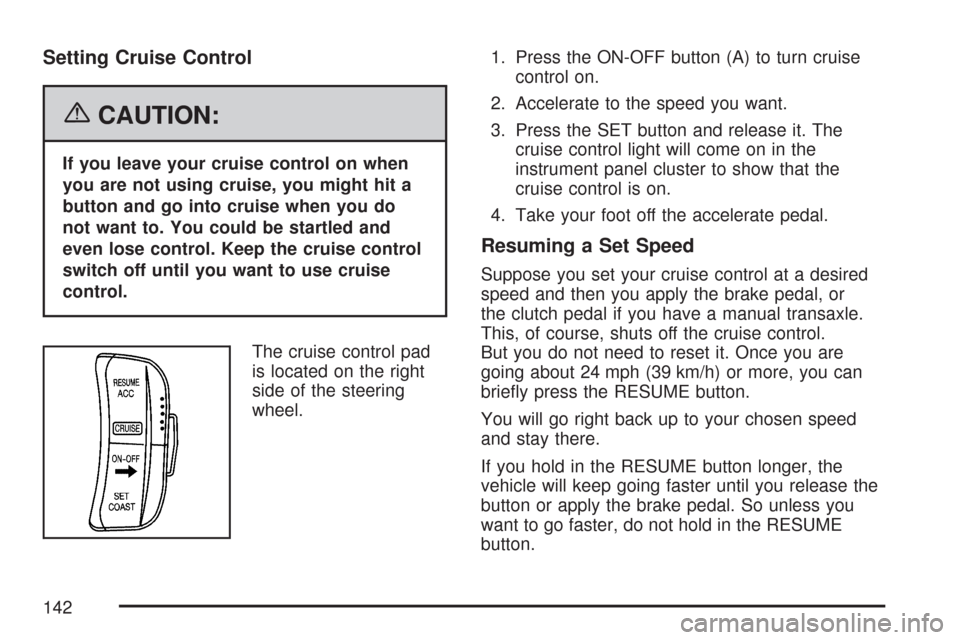
Setting Cruise Control
{CAUTION:
If you leave your cruise control on when
you are not using cruise, you might hit a
button and go into cruise when you do
not want to. You could be startled and
even lose control. Keep the cruise control
switch off until you want to use cruise
control.
The cruise control pad
is located on the right
side of the steering
wheel.1. Press the ON-OFF button (A) to turn cruise
control on.
2. Accelerate to the speed you want.
3. Press the SET button and release it. The
cruise control light will come on in the
instrument panel cluster to show that the
cruise control is on.
4. Take your foot off the accelerate pedal.
Resuming a Set Speed
Suppose you set your cruise control at a desired
speed and then you apply the brake pedal, or
the clutch pedal if you have a manual transaxle.
This, of course, shuts off the cruise control.
But you do not need to reset it. Once you are
going about 24 mph (39 km/h) or more, you can
briefly press the RESUME button.
You will go right back up to your chosen speed
and stay there.
If you hold in the RESUME button longer, the
vehicle will keep going faster until you release the
button or apply the brake pedal. So unless you
want to go faster, do not hold in the RESUME
button.
142
Page 144 of 436
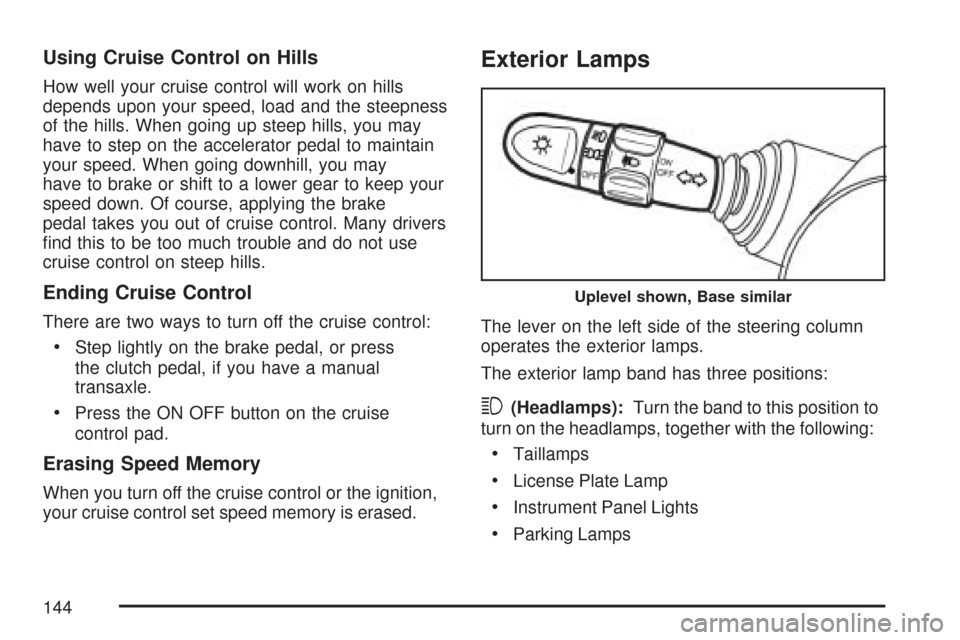
Using Cruise Control on Hills
How well your cruise control will work on hills
depends upon your speed, load and the steepness
of the hills. When going up steep hills, you may
have to step on the accelerator pedal to maintain
your speed. When going downhill, you may
have to brake or shift to a lower gear to keep your
speed down. Of course, applying the brake
pedal takes you out of cruise control. Many drivers
find this to be too much trouble and do not use
cruise control on steep hills.
Ending Cruise Control
There are two ways to turn off the cruise control:
•Step lightly on the brake pedal, or press
the clutch pedal, if you have a manual
transaxle.
•Press the ON OFF button on the cruise
control pad.
Erasing Speed Memory
When you turn off the cruise control or the ignition,
your cruise control set speed memory is erased.
Exterior Lamps
The lever on the left side of the steering column
operates the exterior lamps.
The exterior lamp band has three positions:
3(Headlamps):Turn the band to this position to
turn on the headlamps, together with the following:
•Taillamps
•License Plate Lamp
•Instrument Panel Lights
•Parking Lamps
Uplevel shown, Base similar
144
Page 145 of 436
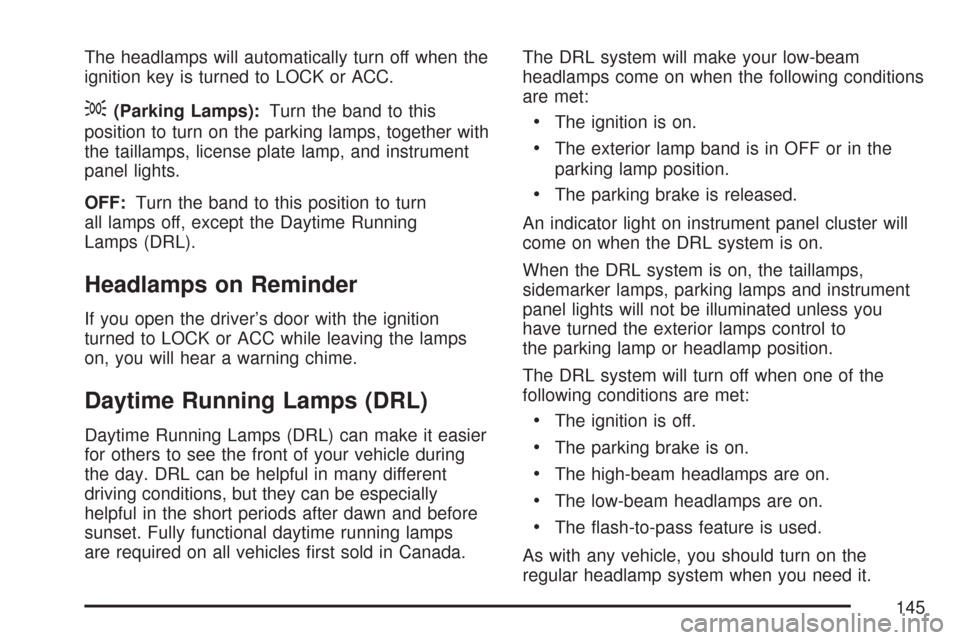
The headlamps will automatically turn off when the
ignition key is turned to LOCK or ACC.
;(Parking Lamps):Turn the band to this
position to turn on the parking lamps, together with
the taillamps, license plate lamp, and instrument
panel lights.
OFF:Turn the band to this position to turn
all lamps off, except the Daytime Running
Lamps (DRL).
Headlamps on Reminder
If you open the driver’s door with the ignition
turned to LOCK or ACC while leaving the lamps
on, you will hear a warning chime.
Daytime Running Lamps (DRL)
Daytime Running Lamps (DRL) can make it easier
for others to see the front of your vehicle during
the day. DRL can be helpful in many different
driving conditions, but they can be especially
helpful in the short periods after dawn and before
sunset. Fully functional daytime running lamps
are required on all vehicles first sold in Canada.The DRL system will make your low-beam
headlamps come on when the following conditions
are met:
•The ignition is on.
•The exterior lamp band is in OFF or in the
parking lamp position.
•The parking brake is released.
An indicator light on instrument panel cluster will
come on when the DRL system is on.
When the DRL system is on, the taillamps,
sidemarker lamps, parking lamps and instrument
panel lights will not be illuminated unless you
have turned the exterior lamps control to
the parking lamp or headlamp position.
The DRL system will turn off when one of the
following conditions are met:
•The ignition is off.
•The parking brake is on.
•The high-beam headlamps are on.
•The low-beam headlamps are on.
•The flash-to-pass feature is used.
As with any vehicle, you should turn on the
regular headlamp system when you need it.
145
Page 146 of 436
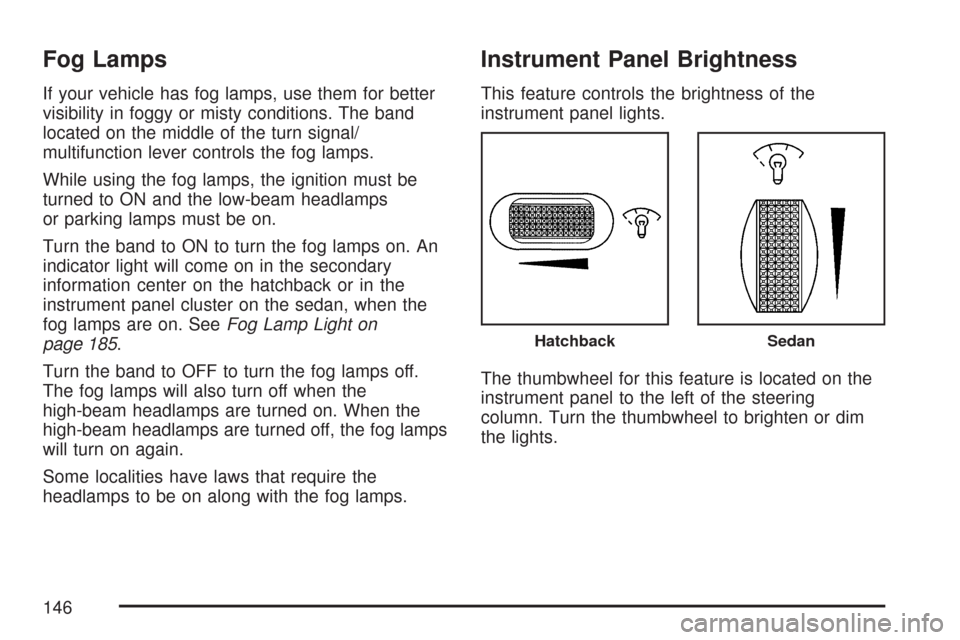
Fog Lamps
If your vehicle has fog lamps, use them for better
visibility in foggy or misty conditions. The band
located on the middle of the turn signal/
multifunction lever controls the fog lamps.
While using the fog lamps, the ignition must be
turned to ON and the low-beam headlamps
or parking lamps must be on.
Turn the band to ON to turn the fog lamps on. An
indicator light will come on in the secondary
information center on the hatchback or in the
instrument panel cluster on the sedan, when the
fog lamps are on. SeeFog Lamp Light on
page 185.
Turn the band to OFF to turn the fog lamps off.
The fog lamps will also turn off when the
high-beam headlamps are turned on. When the
high-beam headlamps are turned off, the fog lamps
will turn on again.
Some localities have laws that require the
headlamps to be on along with the fog lamps.
Instrument Panel Brightness
This feature controls the brightness of the
instrument panel lights.
The thumbwheel for this feature is located on the
instrument panel to the left of the steering
column. Turn the thumbwheel to brighten or dim
the lights.
HatchbackSedan
146
Page 147 of 436
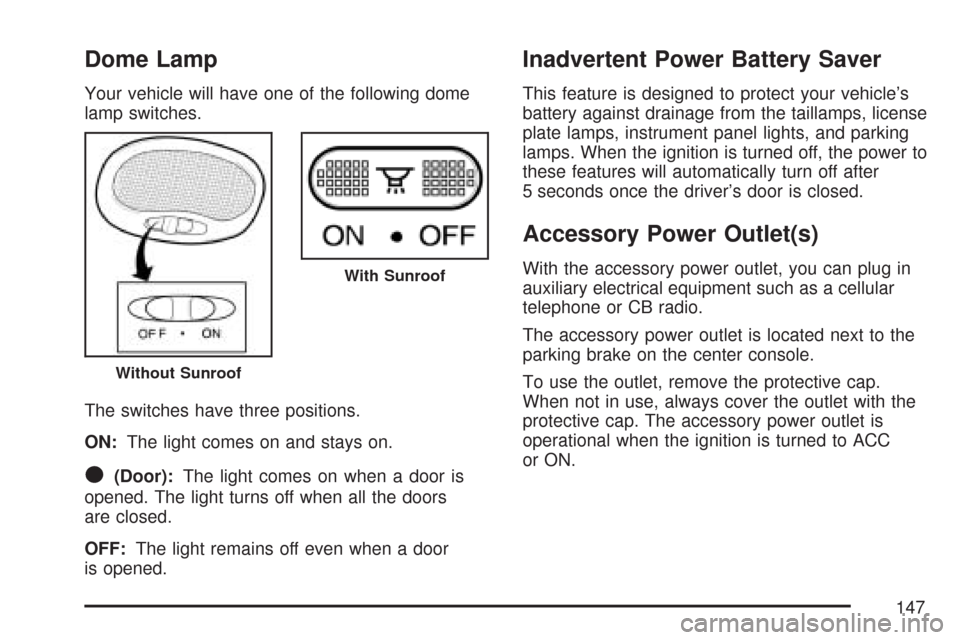
Dome Lamp
Your vehicle will have one of the following dome
lamp switches.
The switches have three positions.
ON:The light comes on and stays on.
O(Door):The light comes on when a door is
opened. The light turns off when all the doors
are closed.
OFF:The light remains off even when a door
is opened.
Inadvertent Power Battery Saver
This feature is designed to protect your vehicle’s
battery against drainage from the taillamps, license
plate lamps, instrument panel lights, and parking
lamps. When the ignition is turned off, the power to
these features will automatically turn off after
5 seconds once the driver’s door is closed.
Accessory Power Outlet(s)
With the accessory power outlet, you can plug in
auxiliary electrical equipment such as a cellular
telephone or CB radio.
The accessory power outlet is located next to the
parking brake on the center console.
To use the outlet, remove the protective cap.
When not in use, always cover the outlet with the
protective cap. The accessory power outlet is
operational when the ignition is turned to ACC
or ON.
Without Sunroof
With Sunroof
147
Page 148 of 436
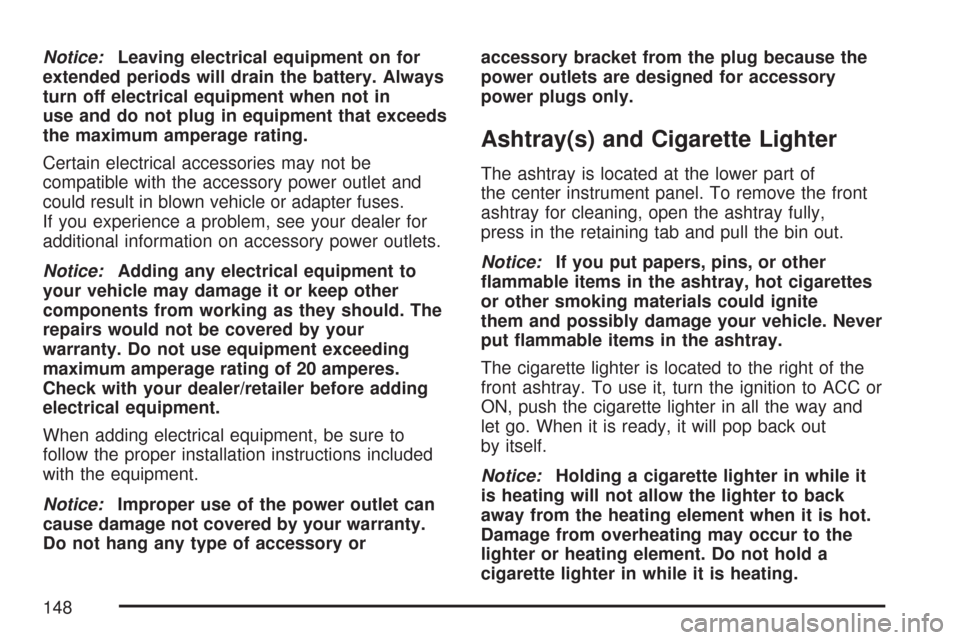
Notice:Leaving electrical equipment on for
extended periods will drain the battery. Always
turn off electrical equipment when not in
use and do not plug in equipment that exceeds
the maximum amperage rating.
Certain electrical accessories may not be
compatible with the accessory power outlet and
could result in blown vehicle or adapter fuses.
If you experience a problem, see your dealer for
additional information on accessory power outlets.
Notice:Adding any electrical equipment to
your vehicle may damage it or keep other
components from working as they should. The
repairs would not be covered by your
warranty. Do not use equipment exceeding
maximum amperage rating of 20 amperes.
Check with your dealer/retailer before adding
electrical equipment.
When adding electrical equipment, be sure to
follow the proper installation instructions included
with the equipment.
Notice:Improper use of the power outlet can
cause damage not covered by your warranty.
Do not hang any type of accessory oraccessory bracket from the plug because the
power outlets are designed for accessory
power plugs only.
Ashtray(s) and Cigarette Lighter
The ashtray is located at the lower part of
the center instrument panel. To remove the front
ashtray for cleaning, open the ashtray fully,
press in the retaining tab and pull the bin out.
Notice:If you put papers, pins, or other
�ammable items in the ashtray, hot cigarettes
or other smoking materials could ignite
them and possibly damage your vehicle. Never
put �ammable items in the ashtray.
The cigarette lighter is located to the right of the
front ashtray. To use it, turn the ignition to ACC or
ON, push the cigarette lighter in all the way and
let go. When it is ready, it will pop back out
by itself.
Notice:Holding a cigarette lighter in while it
is heating will not allow the lighter to back
away from the heating element when it is hot.
Damage from overheating may occur to the
lighter or heating element. Do not hold a
cigarette lighter in while it is heating.
148
Page 151 of 436
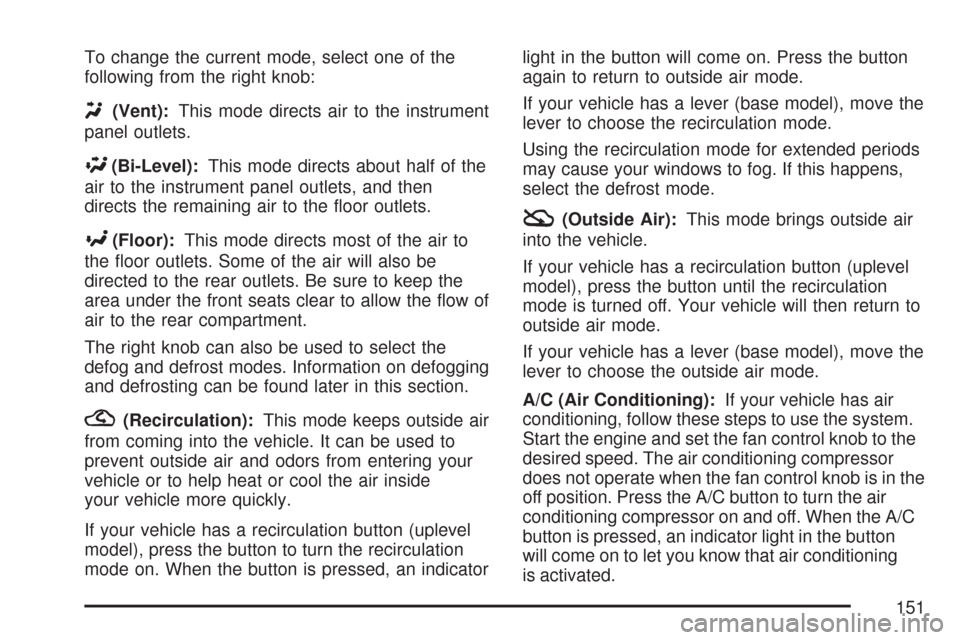
To change the current mode, select one of the
following from the right knob:
Y(Vent):This mode directs air to the instrument
panel outlets.
\(Bi-Level):This mode directs about half of the
air to the instrument panel outlets, and then
directs the remaining air to the floor outlets.
[(Floor):This mode directs most of the air to
the floor outlets. Some of the air will also be
directed to the rear outlets. Be sure to keep the
area under the front seats clear to allow the flow of
air to the rear compartment.
The right knob can also be used to select the
defog and defrost modes. Information on defogging
and defrosting can be found later in this section.
?(Recirculation):This mode keeps outside air
from coming into the vehicle. It can be used to
prevent outside air and odors from entering your
vehicle or to help heat or cool the air inside
your vehicle more quickly.
If your vehicle has a recirculation button (uplevel
model), press the button to turn the recirculation
mode on. When the button is pressed, an indicatorlight in the button will come on. Press the button
again to return to outside air mode.
If your vehicle has a lever (base model), move the
lever to choose the recirculation mode.
Using the recirculation mode for extended periods
may cause your windows to fog. If this happens,
select the defrost mode.
:(Outside Air):This mode brings outside air
into the vehicle.
If your vehicle has a recirculation button (uplevel
model), press the button until the recirculation
mode is turned off. Your vehicle will then return to
outside air mode.
If your vehicle has a lever (base model), move the
lever to choose the outside air mode.
A/C (Air Conditioning):If your vehicle has air
conditioning, follow these steps to use the system.
Start the engine and set the fan control knob to the
desired speed. The air conditioning compressor
does not operate when the fan control knob is in the
off position. Press the A/C button to turn the air
conditioning compressor on and off. When the A/C
button is pressed, an indicator light in the button
will come on to let you know that air conditioning
is activated.
151
Page 153 of 436
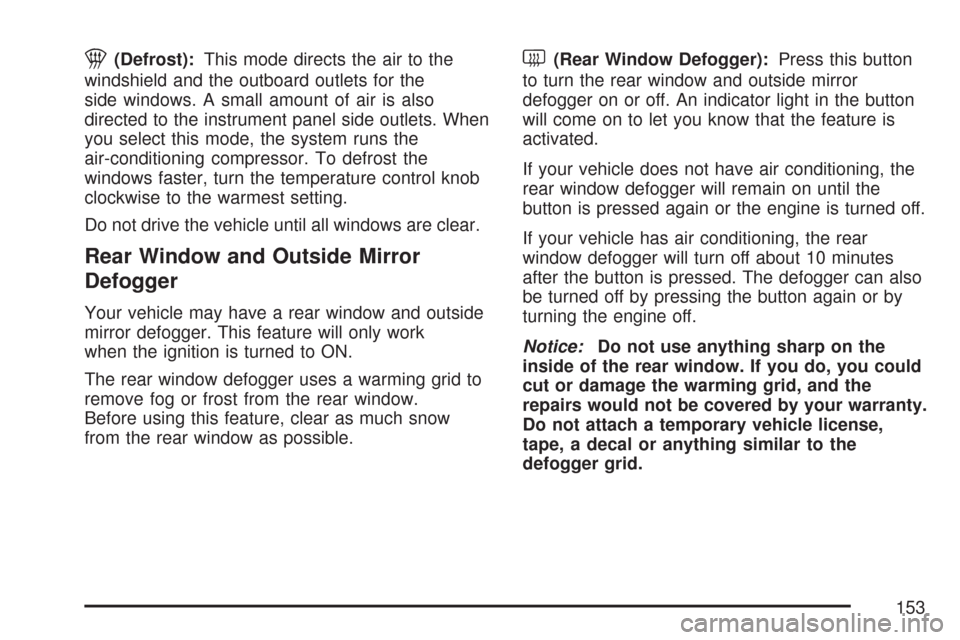
1(Defrost):This mode directs the air to the
windshield and the outboard outlets for the
side windows. A small amount of air is also
directed to the instrument panel side outlets. When
you select this mode, the system runs the
air-conditioning compressor. To defrost the
windows faster, turn the temperature control knob
clockwise to the warmest setting.
Do not drive the vehicle until all windows are clear.
Rear Window and Outside Mirror
Defogger
Your vehicle may have a rear window and outside
mirror defogger. This feature will only work
when the ignition is turned to ON.
The rear window defogger uses a warming grid to
remove fog or frost from the rear window.
Before using this feature, clear as much snow
from the rear window as possible.
<(Rear Window Defogger):Press this button
to turn the rear window and outside mirror
defogger on or off. An indicator light in the button
will come on to let you know that the feature is
activated.
If your vehicle does not have air conditioning, the
rear window defogger will remain on until the
button is pressed again or the engine is turned off.
If your vehicle has air conditioning, the rear
window defogger will turn off about 10 minutes
after the button is pressed. The defogger can also
be turned off by pressing the button again or by
turning the engine off.
Notice:Do not use anything sharp on the
inside of the rear window. If you do, you could
cut or damage the warming grid, and the
repairs would not be covered by your warranty.
Do not attach a temporary vehicle license,
tape, a decal or anything similar to the
defogger grid.
153